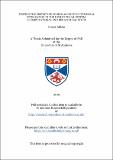Files in this item
Testing the predictive coding account of temporal integration in the human visual system : a computational and behavioural study
Item metadata
| dc.contributor.advisor | Ales, Justin Michael | |
| dc.contributor.author | Aitken, Fraser | |
| dc.coverage.spatial | v, [8], 197 p. | en_US |
| dc.date.accessioned | 2019-12-18T14:30:01Z | |
| dc.date.available | 2019-12-18T14:30:01Z | |
| dc.date.issued | 2019-12-03 | |
| dc.identifier.uri | https://hdl.handle.net/10023/19158 | |
| dc.description.abstract | A major goal of vision science is to understand how the visual system maintains behaviourally relevant perceptions given the level of uncertainty in the signals it receives. One proposed solution is that the visual system applies predictive coding to its inputs based on the integration of prior knowledge and current stimulus features. However, support for some vital aspects of predictive coding in the temporal domain is lacking and simpler accounts of temporal integration also exist. The aim of this thesis was to test two key attributes of predictive coding in time a) does the visual system apply adaptive weighting to prediction errors and b) can the visual system apply probabilistic information learnt from stimulus sequences when making predictions. In chapters 3 & 4, we tested predictive coding’s ideas of how prediction errors are weighted under the theoretical guidance of a temporal integration model linked to predictive processing, called the Kalman filter. Here, both experiments supported predictive coding. We showed that, consistent with the Kalman filter, visual estimates and the way estimation errors were corrected, adapted to stimulus behaviour and viewing conditions. In chapter 5, we assessed the ability of the visual system to integrate conditional relationships present in sequences of stimuli when making predictions. To do this, we inserted a stimulus sequence that changed and omitted trials based on Markov transition probabilities that made some transitions more or less probable and assessed reaction times and omission trial responses. Reaction time data was consistent with predictive coding, in that more predictable changes elicited faster responses. Omission trials data, was though, less clear. When faced with no stimulus, participants did not apply the conditional probabilities in their decisions optimally, instead applying non optimal decision strategies, inconsistent with predictive coding. In summary, this thesis supports the predictive coding of temporal integration but questions its application in all situations. | en_US |
| dc.language.iso | en | en_US |
| dc.publisher | University of St Andrews | |
| dc.relation | Testing the predictive coding account of temporal integration in the human visual system - a computational and behavioural study - Chapter_3 (thesis data) Aitken, F., University of St Andrews, 13 Nov 2019. DOI: https://doi.org/10.17630/de1452f3-e75e-4df9-8780-bdee39678108 | en |
| dc.relation | Testing the predictive coding account of temporal integration in the human visual system - a computational and behavioural study - Chapter_4 (thesis data) Aitken, F., University of St Andrews, 13 Nov 2019. DOI: https://doi.org/10.17630/2f2868c9-03e1-4f11-b116-7df1ab5bc8d4 | en |
| dc.relation | Testing the predictive coding account of temporal integration in the human visual system - a computational and behavioural study - Chapter_5 (thesis data) Aitken, F., University of St Andrews, 13 Nov 2019. DOI: https://doi.org/10.17630/c6697f39-7bd1-4766-b666-d394aeeb717b | en |
| dc.relation.uri | https://doi.org/10.17630/de1452f3-e75e-4df9-8780-bdee39678108 | |
| dc.relation.uri | https://doi.org/10.17630/2f2868c9-03e1-4f11-b116-7df1ab5bc8d4 | |
| dc.relation.uri | https://doi.org/10.17630/c6697f39-7bd1-4766-b666-d394aeeb717b | |
| dc.title | Testing the predictive coding account of temporal integration in the human visual system : a computational and behavioural study | en_US |
| dc.type | Thesis | en_US |
| dc.contributor.sponsor | Wellcome Trust. Institutional Strategic Support Fund (ISSF) | en_US |
| dc.type.qualificationlevel | Doctoral | en_US |
| dc.type.qualificationname | PhD Doctor of Philosophy | en_US |
| dc.publisher.institution | The University of St Andrews | en_US |
| dc.identifier.doi | https://doi.org/10.17630/10023-19158 |
This item appears in the following Collection(s)
Items in the St Andrews Research Repository are protected by copyright, with all rights reserved, unless otherwise indicated.

